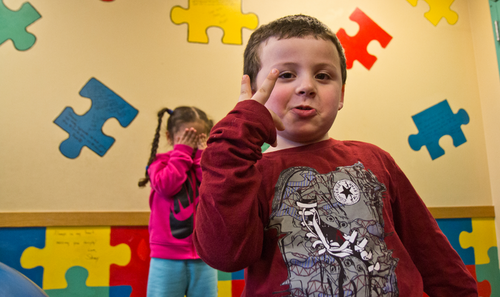
Autism rates in US children have jumped from one in 150 in 2002 to one in 36 in 2020, or 2.8%, according to a new study published by the Centers for Disease Control and Prevention (CDC).

The findings come from the CDC-funded 'Autism and Developmental Disabilities Monitoring Network,' launched in 2000 "to collect data to better understand the number and characteristics of children with autism spectrum disorder and other developmental disabilities living in different areas of the United States."
The program spans 11 states, including Arkansas, Maryland and Tennessee.
Autism, also known as autism spectrum disorder, is a wide-ranging developmental disability that manifests in various ways - but which typically includes trouble with communication and social interactions.
The study also found that boys were far more likely to have autism than girls.
That said, the report also notes that the communities included in the program "are not representative of the entire United States," while other federal autism programs are meant to be nationally representative. As the Epoch Times notes, the last nationwide autism estimate for children aged 3 through 17 was 2.9%, in-line with the latest figures from this study.
Another new paper published by the CDC's Morbidity and Mortality Weekly Report found that more 4-year-olds were being diagnosed with autism from 2016 through early 2020 vs. the previous four years.
One explanation: "Our best guess, consistent with the general rise in autism prevalence rates, is that it is more equitable access to evaluations and diagnoses," according to Kelly Shaw, a CDC epidemiologist and one of the researchers, in a comment to Today.
Autism rates in US children have jumped from one in 150 in 2002 to one in 36 in 2020, or 2.8%, according to a new study published by the Centers for Disease Control and Prevention (CDC).

The findings come from the CDC-funded ‘Autism and Developmental Disabilities Monitoring Network,’ launched in 2000 “to collect data to better understand the number and characteristics of children with autism spectrum disorder and other developmental disabilities living in different areas of the United States.”
The program spans 11 states, including Arkansas, Maryland and Tennessee.
Autism, also known as autism spectrum disorder, is a wide-ranging developmental disability that manifests in various ways – but which typically includes trouble with communication and social interactions.
The study also found that boys were far more likely to have autism than girls.
That said, the report also notes that the communities included in the program “are not representative of the entire United States,” while other federal autism programs are meant to be nationally representative. As the Epoch Times notes, the last nationwide autism estimate for children aged 3 through 17 was 2.9%, in-line with the latest figures from this study.
Another new paper published by the CDC’s Morbidity and Mortality Weekly Report found that more 4-year-olds were being diagnosed with autism from 2016 through early 2020 vs. the previous four years.
One explanation: “Our best guess, consistent with the general rise in autism prevalence rates, is that it is more equitable access to evaluations and diagnoses,” according to Kelly Shaw, a CDC epidemiologist and one of the researchers, in a comment to Today.
Loading…





